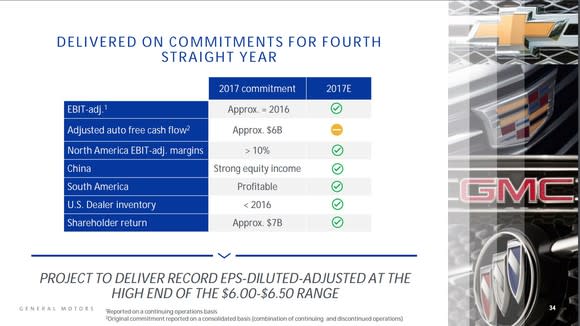Why General Motors Is Feeling Good About 2018 -- and Even Better About 2019
General Motors (NYSE: GM) said that it expects its results in 2018 to look a lot like its pre-tax 2017 results -- and that those pre-tax 2017 results will end up "at the high end" of the optimistic guidance it gave a year ago.
GM also noted that while its earnings may not grow much in 2018, 2019 has the potential to be a record year.

GM's all-new line of crossover SUVs helped boost profits in 2017. Models like the Chevrolet Traverse, introduced last fall, should help GM offset profit headwinds in 2018. Image source: General Motors.
A good operating result for 2017
GM won't report its fourth-quarter and full-year 2017 earnings until Feb. 5. But in a briefing on Tuesday, GM executives gave investors a preview: They said that the company's 2017 pre-tax earnings will come in at the "high end" of the range it had forecast at the beginning of 2017, $6 to $6.50 per share.
That should be an all-time profit record for GM, its third in a row, and a little better than GM had previously expected. During GM's third-quarter 2017 earnings report, CFO Chuck Stevens said that GM expected its full-year earnings to land in the middle of that range. But, GM noted, its after-tax 2017 results will be impacted by a $7 billion one-time item, an accounting charge related to the new tax-code changes.
As for other metrics like revenue, operating margins in North America, and cash returned to shareholders, Stevens said that GM will meet all of the upbeat guidance it gave early in the year, with the possible exception of free cash flow.

Image source: General Motors.
There's a good explanation for the cash flow miss, as Stevens explained:
It does look like we could come up short on our free cash flow target, but that's primarily due to reduced production -- lower production in order to balance supply and demand and rightsize inventory and end the year down 90,000 units. Despite that, we still returned about $7 billion to shareholders in 2017.
GM cut production at several of its North American factories in the third quarter in an effort to bring U.S. inventories of some slow-selling models under control. It worked -- GM ended the year with a very reasonable 63 days' supply of vehicles in inventory in the United States. But because GM shipped fewer vehicles than it had expected, cash flow will be down.
About that $7 billion one-time charge
GM said that it will take a one-time charge of $7 billion against its fourth-quarter earnings. That sounds worrisome, but note: It's due to an accounting change. It's not something that will affect GM's cash levels.
Specifically, it's a charge related to the new tax-code changes in the United States. GM has for several years carried "deferred tax assets" on its balance sheet. These are tax deductions that GM is entitled to take because of the massive losses it posted during the last recession.
The issue here is simple: With the corporate tax rate dropping to 21% from 35%, those deductions are worth less on paper -- $7 billion less, as it turns out.
GM's guidance: 2018 will look a lot like 2017
Stevens said that there will be both good and bad news -- or as he put it, "headwinds and tailwinds" -- on the profit front in 2018.
The headwinds that are likely to hurt its profits include:
The costs of launching GM's all-new pickups later in the year.
Continued pricing pressures in both the U.S. and China that could squeeze GM's operating margins.
Weakening used-car prices will impact the returns GM's captive-financing arm gets when it sells off-lease vehicles at auction.
The U.S. new-vehicle market is probably past its cyclical peak, meaning that sales could slow across the industry.
But as Stevens sees it, those headwinds will be largely offset by some favorable tailwinds:
A full year of results for GM's hot-selling new crossovers.
More benefits from GM's ongoing global cost-cutting campaign.
Growth in what GM calls "adjacencies," including OnStar and GM Financial.
Ongoing improvements in GM's overseas operations.
The upshot: GM expects its 2018 pre-tax profit and "core automotive adjusted free cash flow" to be "generally in line" with its 2017 results. ("Core automotive adjusted free cash flow" is GM-speak for free cash flow related to its "core automotive" business, which excludes its self-driving effort and GM Financial, that has been "adjusted" in small ways to account for some quirks of GM's corporate structure.)
Given the potential for weakness in the U.S. market, it's an optimistic forecast. It's certainly far more optimistic than rival Ford Motor Company's (NYSE: F) 2018 guidance, which predicts that Ford's earnings will come in even lower than its disappointing 2017 result.
Stevens also noted that GM expects its self-driving subsidiary, Cruise Automation, to spend about $1 billion in 2018. It will make additional capital expenditures of around $8.5 billion in its "core automotive" business, mostly related to future products.
On the shareholder side, GM expects to maintain its current quarterly dividend payment ($0.38 per share), and to continue its ongoing share-repurchase program, which has about $3.5 billion remaining on its existing authorization.

GM's all-new 2019 Chevrolet Silverado will begin arriving at dealers at the end of 2018, just in time to give GM a profit boost next year and beyond. Image source: General Motors.
One more thing: 2019 could be even better
Stevens noted that while 2018's results will likely be flat versus 2017's, profit growth could resume in 2019 and beyond as long as the U.S. market stays healthy, thanks to a few GM initiatives that are poised to begin bearing fruit after this year:
The ongoing Cadillac revival will hit its stride with three all-new crossover models that should drive significant sales growth in both the U.S. and China. The first of those new crossovers, to be called the XT4, is expected to launch in the second half of 2018.
GM South America and its other international operations (outside of China) should be solidly profitable by 2019.
GM is launching a new line of vehicles designed specifically for emerging markets, beginning in 2019.
Cruise Automation is working on a self-driving vehicle for urban ride-hailing duty. That's currently expected to launch in 2019 and to become a significantly profitable business over time.
Long story short: 2017 was a very good year for GM, 2018 should be about as good, and 2019 could be even better.
More From The Motley Fool
John Rosevear owns shares of Ford and General Motors. The Motley Fool owns shares of and recommends Ford. The Motley Fool has a disclosure policy.

 Yahoo Finance
Yahoo Finance 